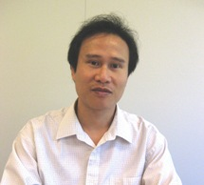High efficient infrared light emission from silicon LEDs
Promotion date: 28 September 2007
| In short my thesis focuses on the development of a high efficient, high speed light emitting device in silicon. Silicon is important because it is a cheap material widely used in industry. Nowadays a most advanced chip includes more than 1 billion transistors while interconnects within the chip are made of metal wires. Since the number of transistors in a chip are still increasing all the time, the metal wires need to be smaller and closer together thus causing problems of heat, leakage, speed, and cross-talk. It is predicted that fundamental limits will be reached in the coming decade. To solve these problems, one possibility is that the metal wires are replaced by optical wires, meaning that we use photons instead of electrons for data transmission. However, it is not easy to make a silicon device which can emit enough light, because of the fundamental limitation of silicon. All over the world quite a number of groups are investing time and money in this. In order to make the silicon light emission efficient we developed a new device structure that allows confining the carriers in a limited space. Electrons and holes being injected into this confined silicon volume will have more chance to directly meet each other thus generating light with a higher efficiency. |
But how do you confine electrons and holes in a small space?
Yes, of course, that was not easy. The properties of silicon change at the nanoscale and we used those properties. In our new structure a very small access layer for electrons and for holes was made by locally thinning down the silicon layer at a desired position. In this way the small access layer acts as a barrier which confines electrons and holes together.
And this is a new development?
Yes, we are quite happy with that. It is an interesting principle that already led to several high quality publications (e.g. in IEEE Electron Device Letters) and after we reported it several companies, like NXP semiconductors, showed their interest.
Make a guess, when do you think that this principle will be deployed in a real application?
Oh, that is very difficult to tell. We proved the concept, but to make a real application it needs to be industrialized and non-conflicting with the normal manufacturing of a silicon chip. Thinning down silicon layer to 5 nm thick is a critical step, and we even want to thin it further to 3 nm because at that thickness we expect a lager band-gap energy of silicon, i.e. a higher barrier for electrons and holds. So reproducibility is problem. In our devices the access layer of 5 nm thick did not always perform.
Furthermore, we need to develop a structure (called detector) that can collect the emitted light and we also need a waveguide layer (optical wire) connecting between the emitter and the detector. It means that we indeed need a complete system including light emitters, waveguides, and detectors.
So, to come back to the question, we estimate a few years yet.
Will you continue the work?
As I said NXP is interested and they (in cooperation with STW) offered me a post-doc position for six months. So I will work on it for a few more months to develop it in a more industrial direction. After that I will go to Germany. I am looking forward to acquiring more knowledge and skills in Europe, but in the long run I may want to return to Vietnam to work there with my family. My wife is a mathematician doing a PhD in Oslo.
How did you get from Vietnam to Twente?
I studied at Hanoi University of Technology and ITIMS (International Training Institute for Material Science), where I did my Master’s, has long standing close collaborations with Twente University. I was interested in the project and got a position.
So what did you find when you arrived here?
I like the country and the people in my group. The atmosphere is very relaxed and open and efficient as well. Language is difficult, but I was helped along.
What didn’t you like?
There are always things in life that are less agreeable. But they are minor and not worth complaining about.
Did you experience moments of despair like nearly every other PhD student does, quite often in the second year?
Mine were at the beginning, when I arrived in the Netherlands. I came from a completely different field (from magnetic materials change to semiconductors) and I had to get used to the subject. After some work in the clean room and contacts with others, I found my footing.
For the summary of the thesis, click here

